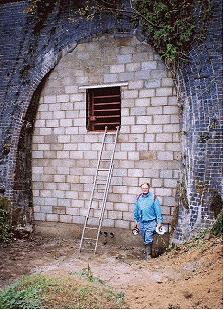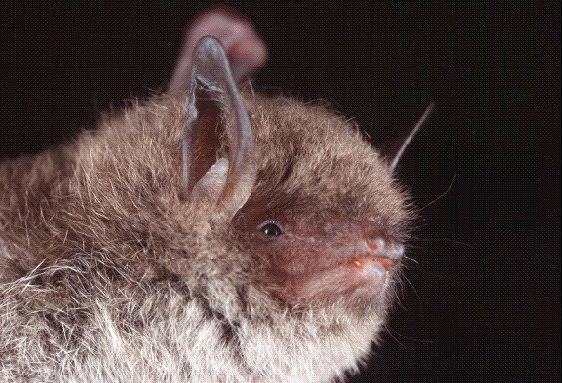The building work to create the bat hibernaculum was outside the scope of the Parish Councilís insurance cover for volunteers, and it was necessary to secure financial support from three additional sources before this major habitat creation project could proceed.
 The Esmee Fairbairn Foundation made a special grant of £5,500, One World Wildlife (formerly The Biodiversity Trust) provided £5,000, Oxfordshire County Council spent at least £2,750, and Horspath Parish Council together with local residents supported the project by providing additional materials and services. The engineering plans for the bat hibernaculum were drawn by Donald Gray, of Gray Design in Horspath, to meet the detailed requirements of English Nature. Another of our volunteers from within the village, Dr. Celia Maier, oversaw the project for the Bat Conservation Trust.
The Esmee Fairbairn Foundation made a special grant of £5,500, One World Wildlife (formerly The Biodiversity Trust) provided £5,000, Oxfordshire County Council spent at least £2,750, and Horspath Parish Council together with local residents supported the project by providing additional materials and services. The engineering plans for the bat hibernaculum were drawn by Donald Gray, of Gray Design in Horspath, to meet the detailed requirements of English Nature. Another of our volunteers from within the village, Dr. Celia Maier, oversaw the project for the Bat Conservation Trust.
 Bob Hamlet, a local building contractor in Horspath, was engaged by Oxfordshire County Council to build a double-skinned block wall at each end of the tunnel around a structure of steel box girders, and to infill this with concrete. Howard Engineering of Milton Common fabricated and installed the steelwork and built the grilled steel doors, the access platform and internal ladders, so that the hibernaculum is accessible only to keyholders via a removable external ladder to reach these doors, positioned some 3 metres off the ground, at each end of the tunnel.
Bob Hamlet, a local building contractor in Horspath, was engaged by Oxfordshire County Council to build a double-skinned block wall at each end of the tunnel around a structure of steel box girders, and to infill this with concrete. Howard Engineering of Milton Common fabricated and installed the steelwork and built the grilled steel doors, the access platform and internal ladders, so that the hibernaculum is accessible only to keyholders via a removable external ladder to reach these doors, positioned some 3 metres off the ground, at each end of the tunnel.
 These doors are now securely locked to prevent the hibernating bats from being disturbed by intruders during the winter months when there is no food available for them.
These doors are now securely locked to prevent the hibernating bats from being disturbed by intruders during the winter months when there is no food available for them.
Both tunnel end walls also have small apertures at ground level to permit the inflow of stream water from the Littleworth end, and the outflow of groundwater seepage through the tunnel roof, together with some of this through-flow of stream water, at the Horspath end, where the water level inside the tunnel can be regulated by a series of drain pipes and overflow tubes. These same tubes serve as air vents, and outlets for the frogs and toads which are believed to migrate annually through this tunnel to spawn in the pools. The increased humidity within the tunnel as a result of this controlled flooding will enhance the range of conditions for the hibernating bats.
 Volunteers constructed a raised walkway above the floodwater by stacking reclaimed stone and blocks alongside one wall of the tunnel at the Horspath end. The water quality of the outflow from the tunnel is very good, and this water contains fresh water shrimps (gammarus pulex) in great abundance in confirmation of this. Volunteers painted navigation marks onto the tunnel walls at 10 metre intervals to facilitate future monitoring of the bats, and a preliminary temperature survey was undertaken of the walls and ceiling of the tunnel throughout its 485 metre length using infra-red remote thermometers.
Volunteers constructed a raised walkway above the floodwater by stacking reclaimed stone and blocks alongside one wall of the tunnel at the Horspath end. The water quality of the outflow from the tunnel is very good, and this water contains fresh water shrimps (gammarus pulex) in great abundance in confirmation of this. Volunteers painted navigation marks onto the tunnel walls at 10 metre intervals to facilitate future monitoring of the bats, and a preliminary temperature survey was undertaken of the walls and ceiling of the tunnel throughout its 485 metre length using infra-red remote thermometers.
The tunnel gates were then closed in October, before any bats had returned, so that only Licensed Bat Handlers from the Oxfordshire Bat Group would have access until the end of the hibernation season in April.
Because there was still some building debris remaining in the tunnel, the drain tubes at the Horspath end were left open in October, which proved to
be a sensible precaution as the water level rose very quickly to flow out through the
100 mm overflow tubes after the heavy rainfall in the last week of December 2002, and this was a useful test of the system for controlling the water levels.
Daubenton's Bat Photo: John Kaczanow, Bat Conservation Trust

It is hoped that the Daubentonís Bats, which were identified flying in the Area during the summer by volunteers using an ultrasonic bat detector, will return to hibernate in the tunnel, where they will have a plentiful supply of midges to feed upon in the new wetland just outside the Horspath entrance.
| Copyright ©
Martin Harris & Alan Simpson 2003 |
Back to the Index |
Last Updated 2003-04-17 |
 The Esmee Fairbairn Foundation made a special grant of £5,500, One World Wildlife (formerly The Biodiversity Trust) provided £5,000, Oxfordshire County Council spent at least £2,750, and Horspath Parish Council together with local residents supported the project by providing additional materials and services. The engineering plans for the bat hibernaculum were drawn by Donald Gray, of Gray Design in Horspath, to meet the detailed requirements of English Nature. Another of our volunteers from within the village, Dr. Celia Maier, oversaw the project for the Bat Conservation Trust.
The Esmee Fairbairn Foundation made a special grant of £5,500, One World Wildlife (formerly The Biodiversity Trust) provided £5,000, Oxfordshire County Council spent at least £2,750, and Horspath Parish Council together with local residents supported the project by providing additional materials and services. The engineering plans for the bat hibernaculum were drawn by Donald Gray, of Gray Design in Horspath, to meet the detailed requirements of English Nature. Another of our volunteers from within the village, Dr. Celia Maier, oversaw the project for the Bat Conservation Trust.
 Bob Hamlet, a local building contractor in Horspath, was engaged by Oxfordshire County Council to build a double-skinned block wall at each end of the tunnel around a structure of steel box girders, and to infill this with concrete. Howard Engineering of Milton Common fabricated and installed the steelwork and built the grilled steel doors, the access platform and internal ladders, so that the hibernaculum is accessible only to keyholders via a removable external ladder to reach these doors, positioned some 3 metres off the ground, at each end of the tunnel.
Bob Hamlet, a local building contractor in Horspath, was engaged by Oxfordshire County Council to build a double-skinned block wall at each end of the tunnel around a structure of steel box girders, and to infill this with concrete. Howard Engineering of Milton Common fabricated and installed the steelwork and built the grilled steel doors, the access platform and internal ladders, so that the hibernaculum is accessible only to keyholders via a removable external ladder to reach these doors, positioned some 3 metres off the ground, at each end of the tunnel.
 These doors are now securely locked to prevent the hibernating bats from being disturbed by intruders during the winter months when there is no food available for them.
These doors are now securely locked to prevent the hibernating bats from being disturbed by intruders during the winter months when there is no food available for them.
 Volunteers constructed a raised walkway above the floodwater by stacking reclaimed stone and blocks alongside one wall of the tunnel at the Horspath end. The water quality of the outflow from the tunnel is very good, and this water contains fresh water shrimps (gammarus pulex) in great abundance in confirmation of this. Volunteers painted navigation marks onto the tunnel walls at 10 metre intervals to facilitate future monitoring of the bats, and a preliminary temperature survey was undertaken of the walls and ceiling of the tunnel throughout its 485 metre length using infra-red remote thermometers.
Volunteers constructed a raised walkway above the floodwater by stacking reclaimed stone and blocks alongside one wall of the tunnel at the Horspath end. The water quality of the outflow from the tunnel is very good, and this water contains fresh water shrimps (gammarus pulex) in great abundance in confirmation of this. Volunteers painted navigation marks onto the tunnel walls at 10 metre intervals to facilitate future monitoring of the bats, and a preliminary temperature survey was undertaken of the walls and ceiling of the tunnel throughout its 485 metre length using infra-red remote thermometers.
